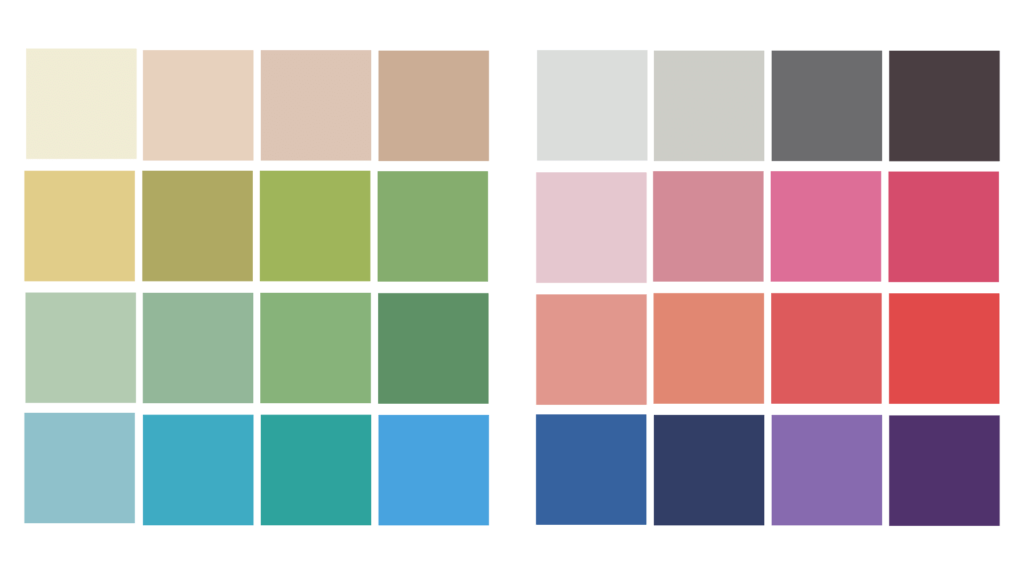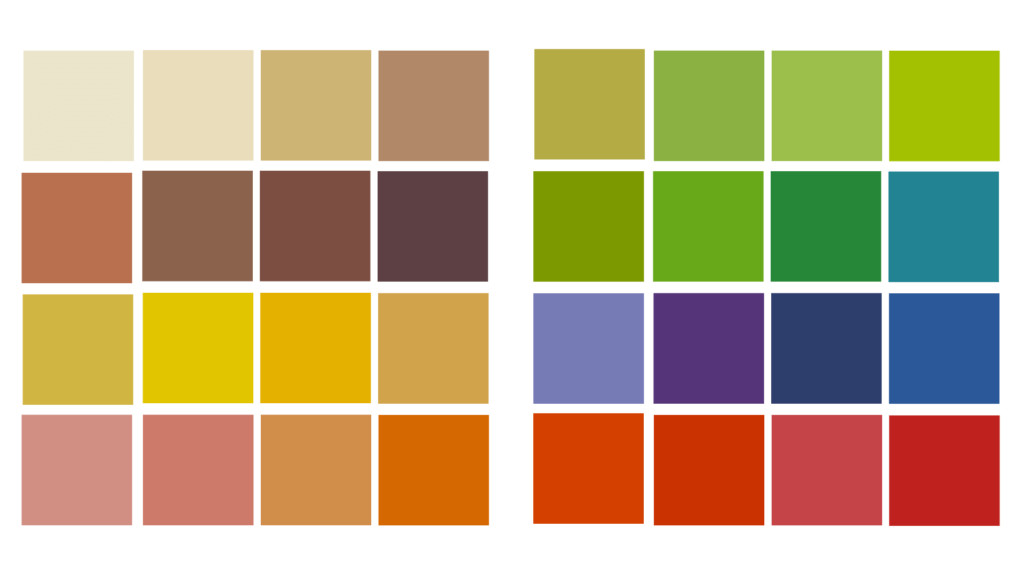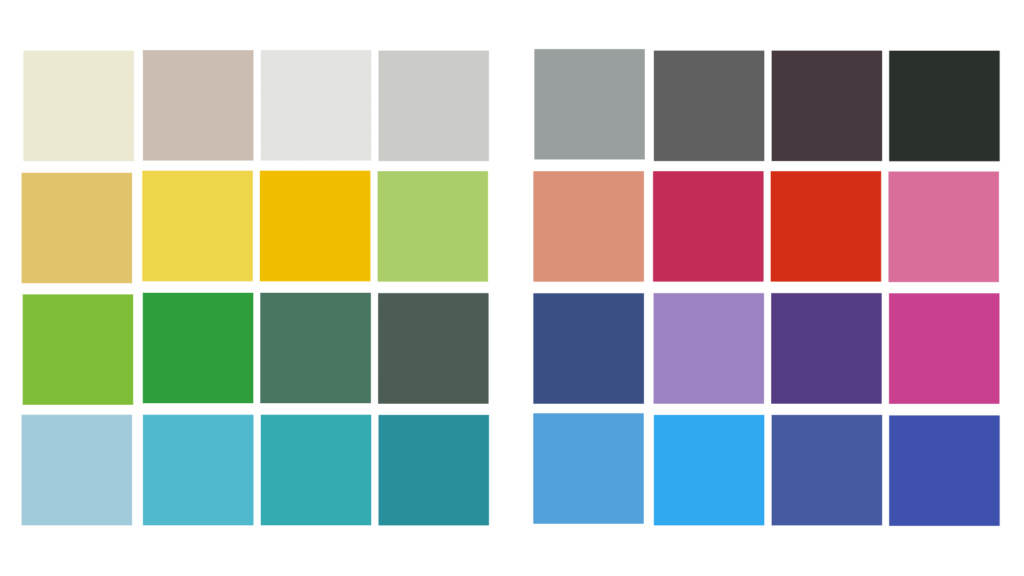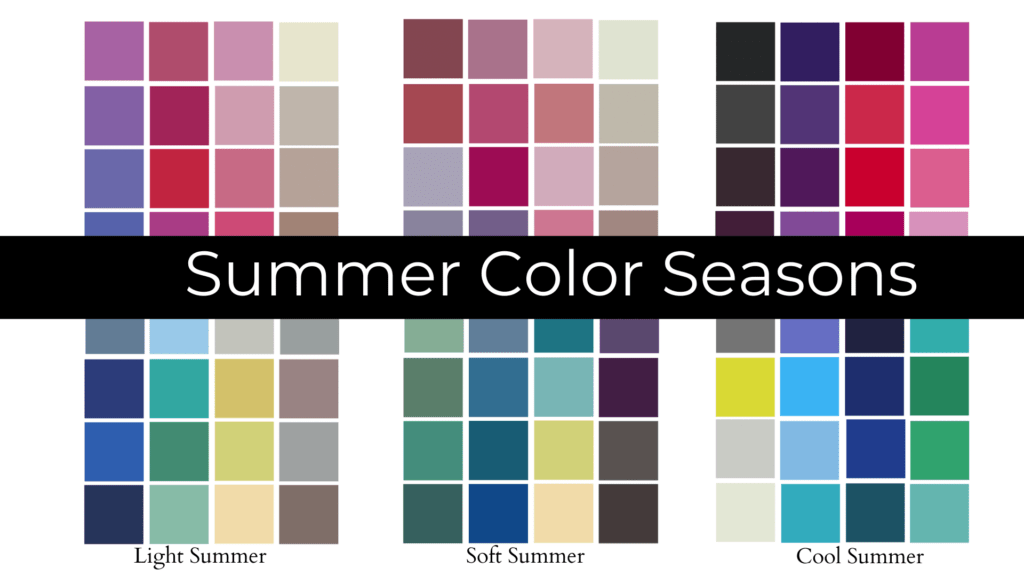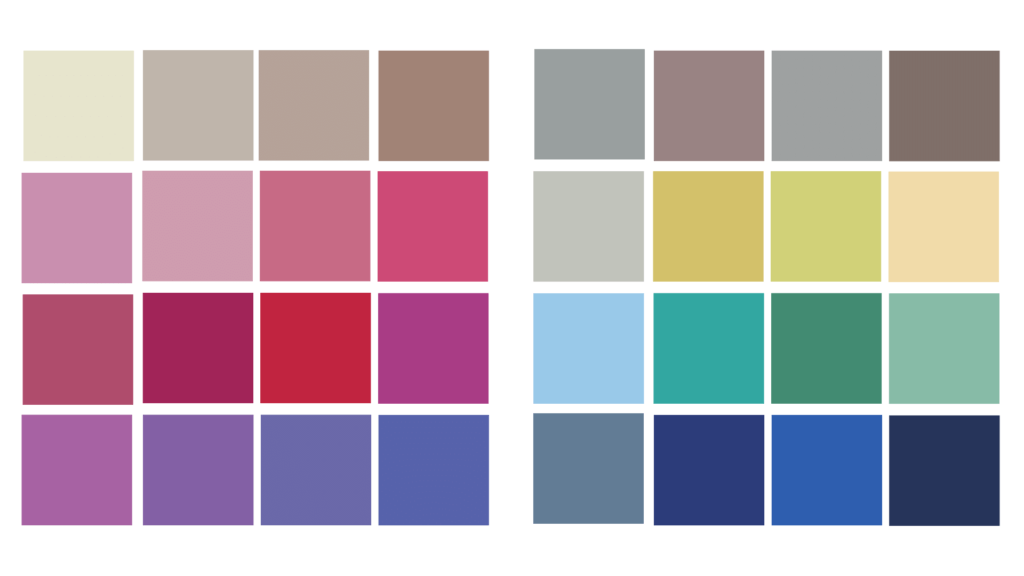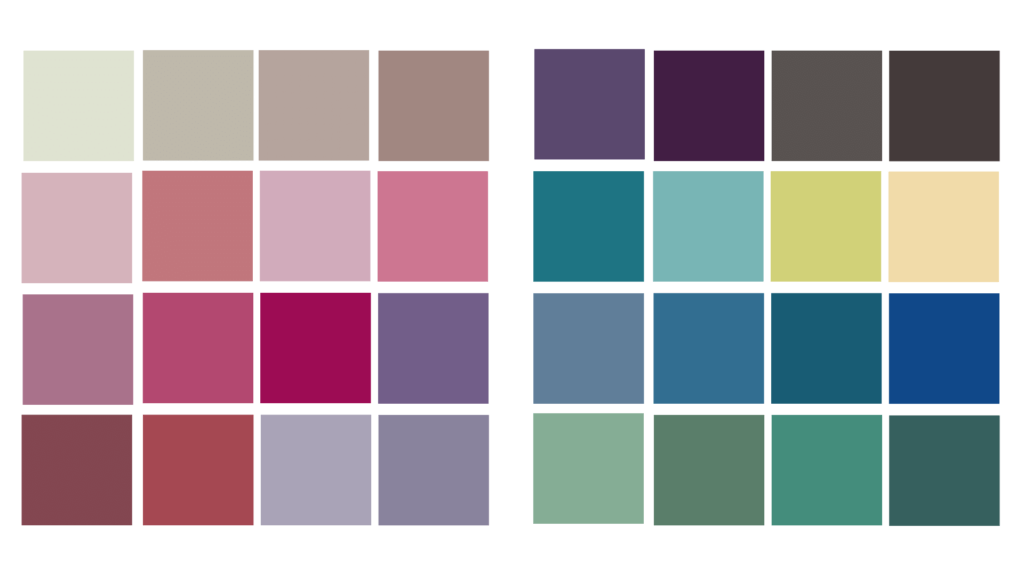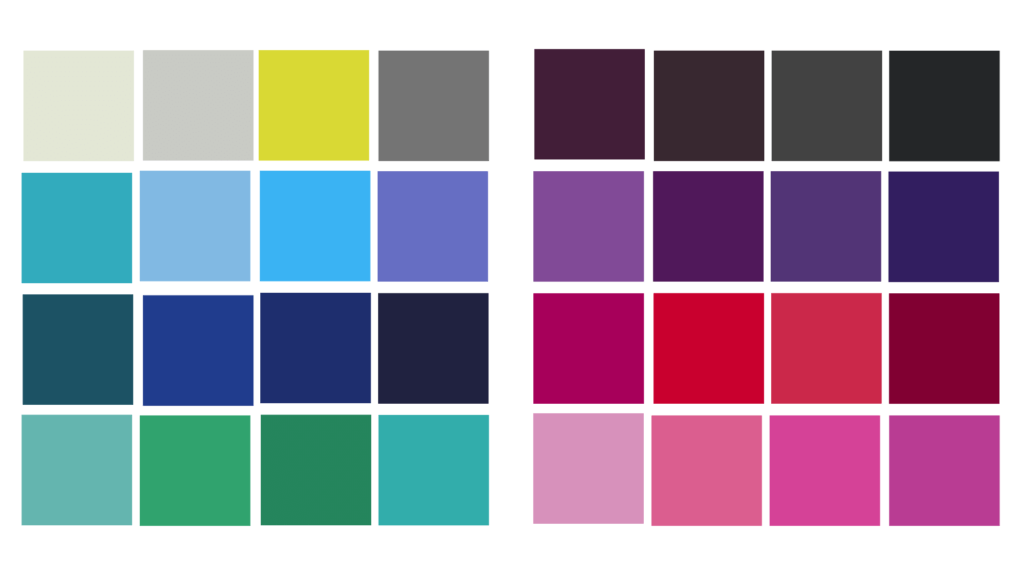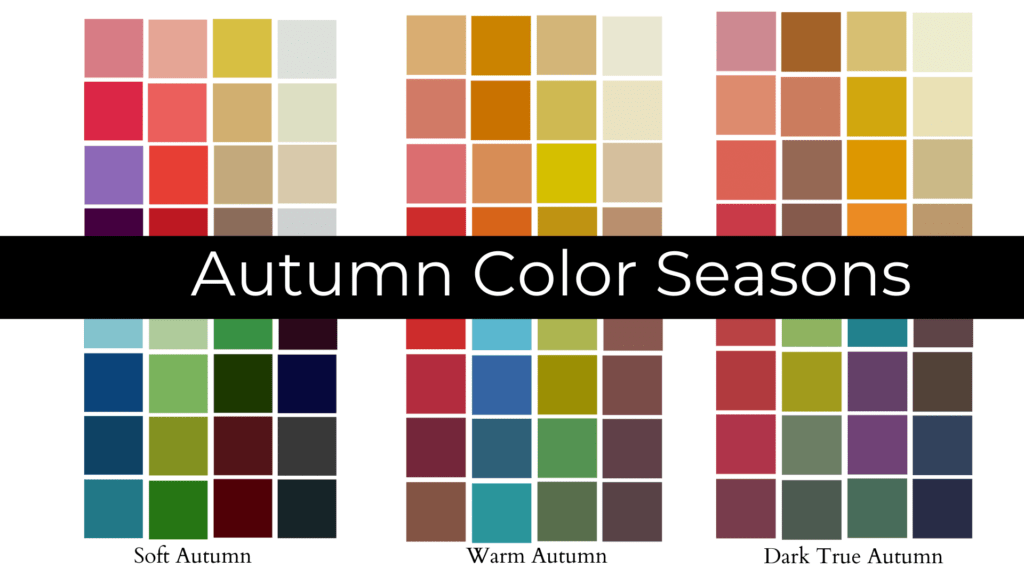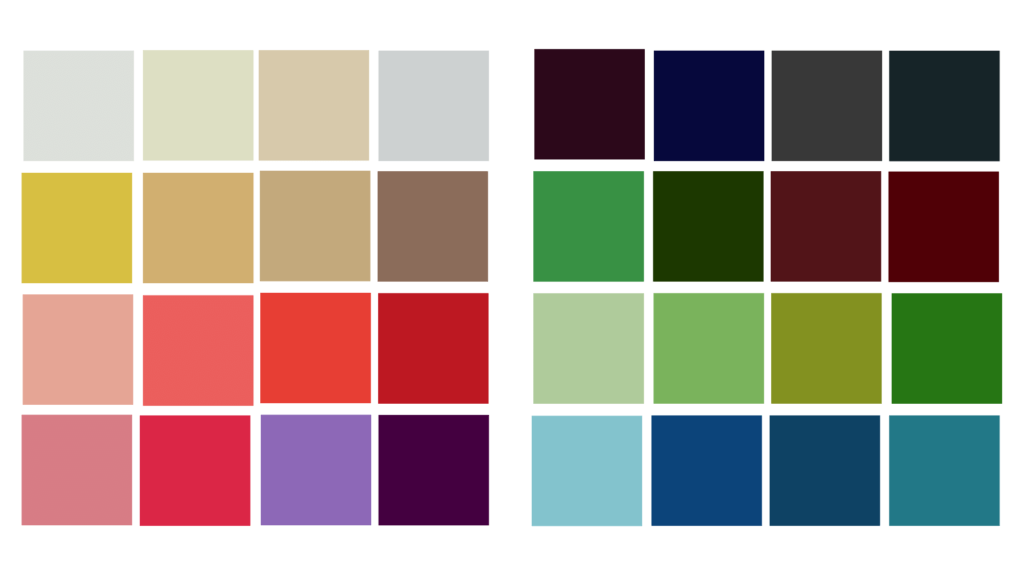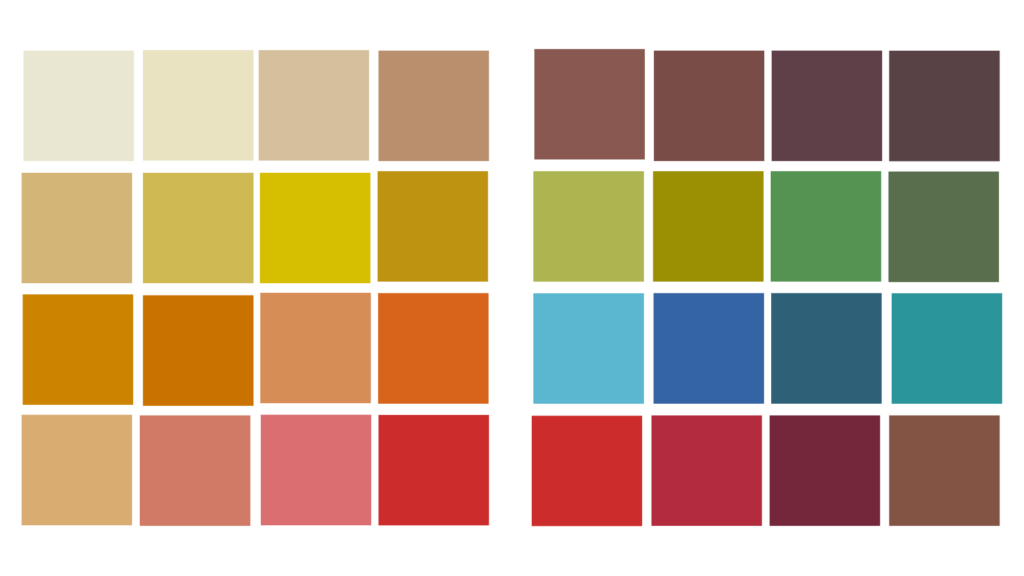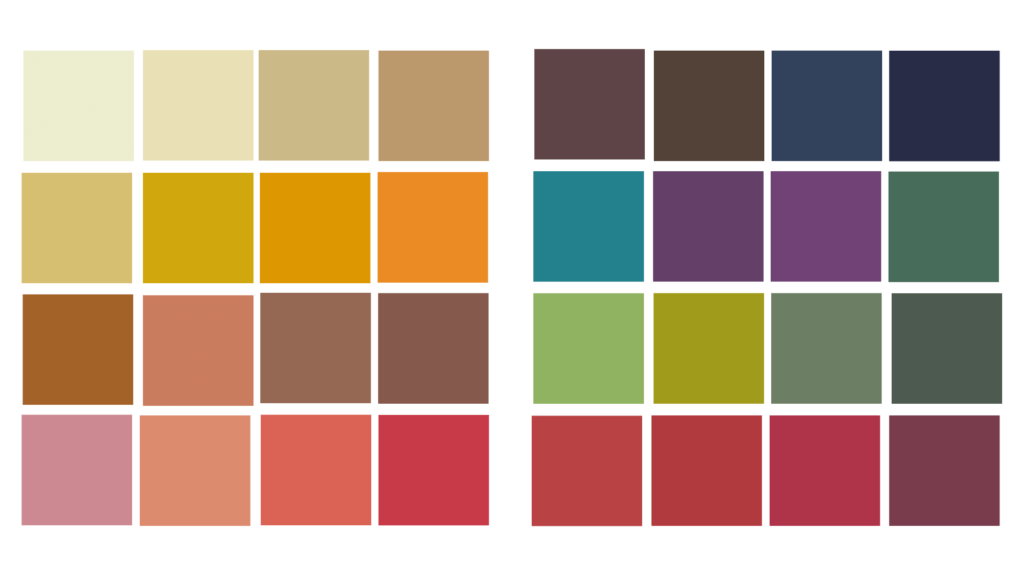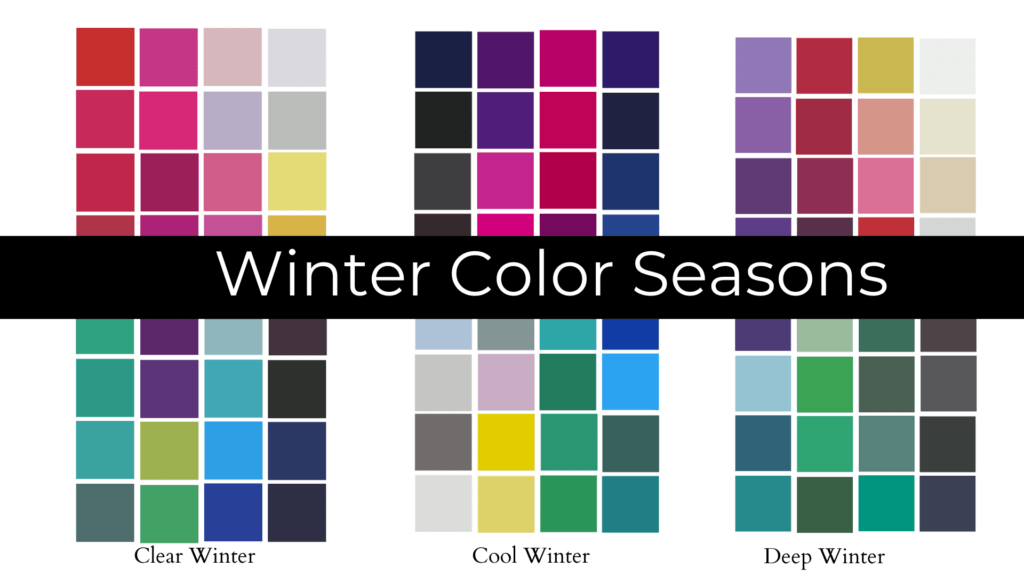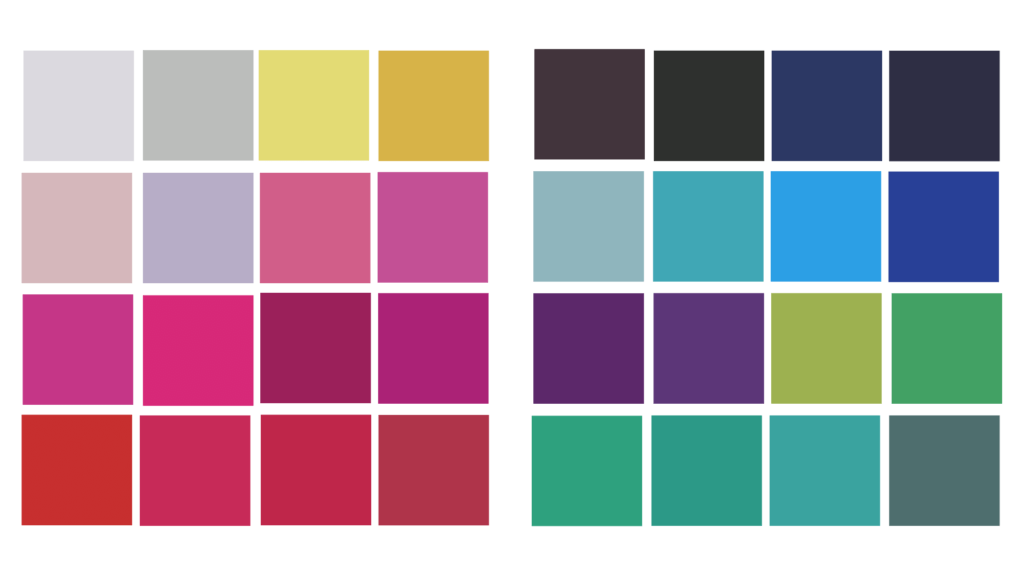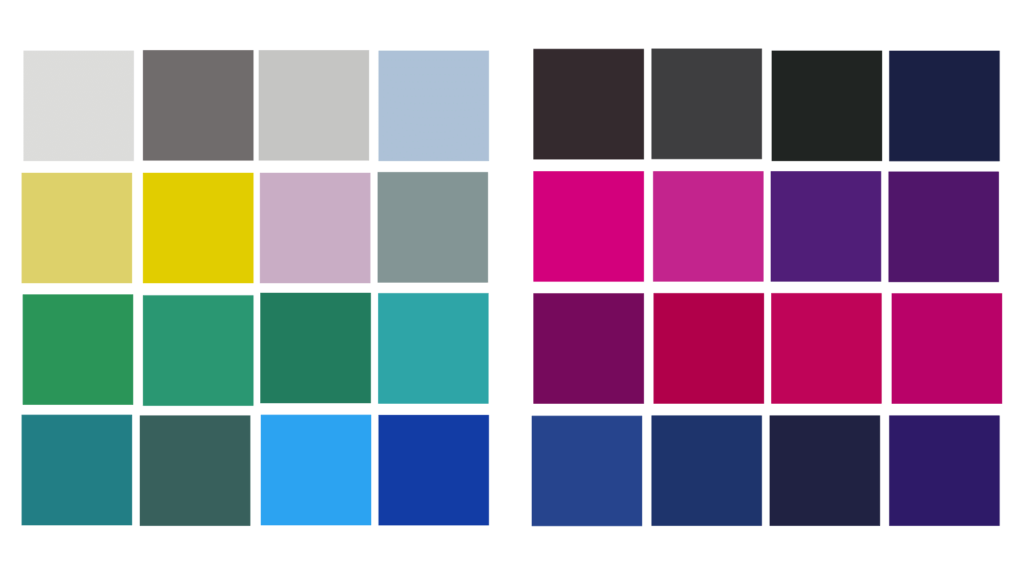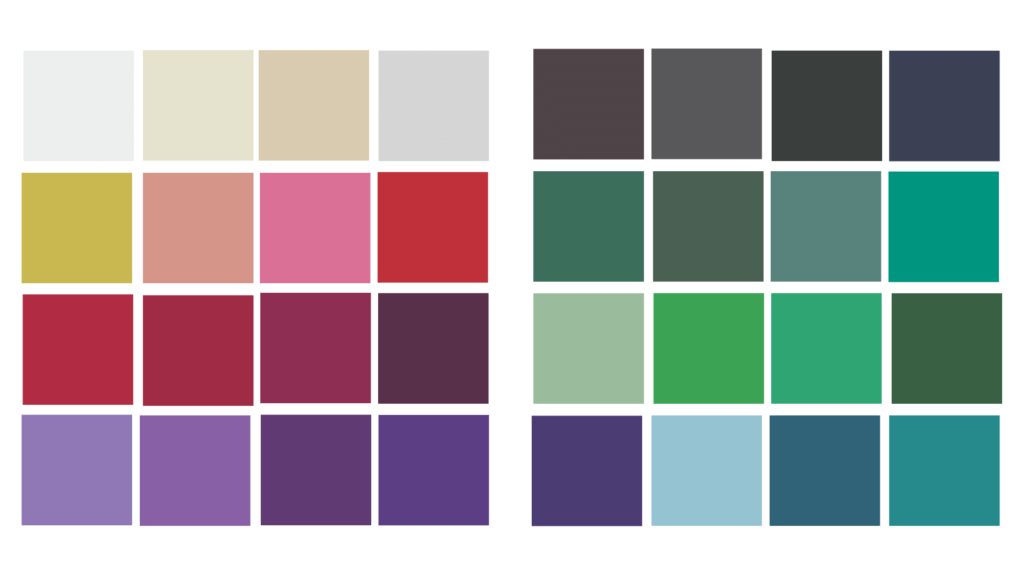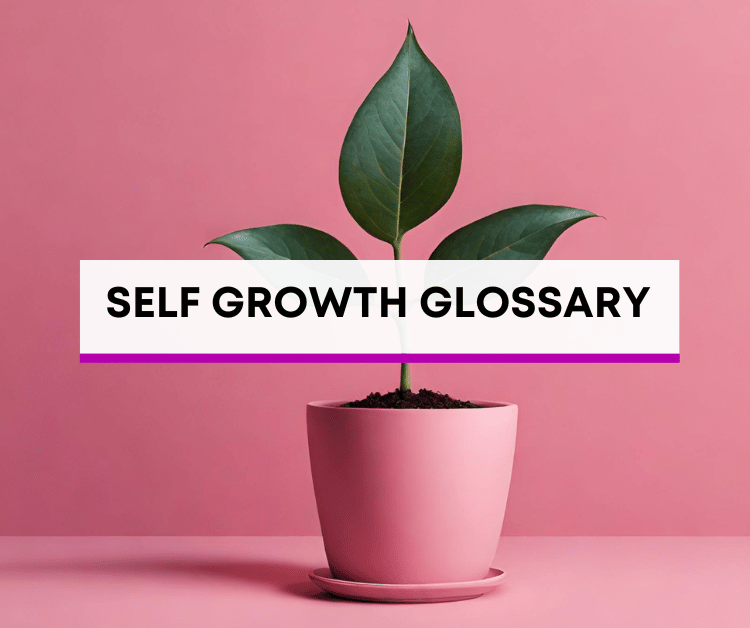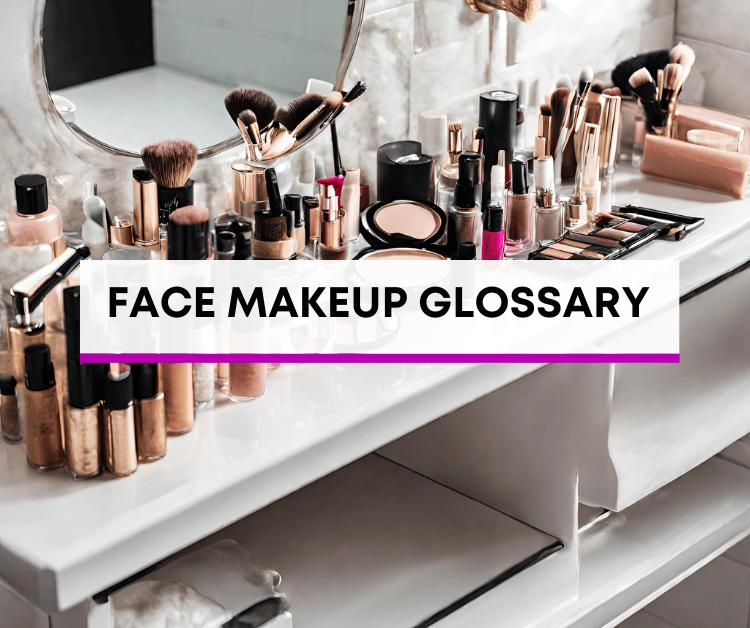Have you ever noticed how the right colors can make you look and feel amazing?
It’s true! Whether it’s enhancing your natural beauty or masking any tiredness, colors play a huge role. I’ve experienced this firsthand, having used color tactics professionally since 2008.
Back in my days as a practicing makeup artist, color matching was a crucial part of every makeup and skincare consult.
I’ve even used colors to tell brand stories for some of the largest companies in the world.
However, it wasn’t until I decided to revamp my wardrobe that I truly delved into the practices of color season theory.
This post will break down color seasons for you to help you
Color Seasons Basics
Let’s dive into the basics of color seasons. It’s like having your own personal stylist to help you shine! Here’s what you need to know:
What are color seasons? Picture them as color categories tailored to suit you, based on your eye color, hair color, and skin tone. They’re like your custom palette of flattering hues.
*As an Amazon Associate, we earn from qualifying purchases at no additional cost to you.
How do they work? Color seasons guide you in choosing the colors that make you look your best. By understanding your color season, you can effortlessly select clothes and makeup that enhance your natural beauty.
Why are they important? They simplify the process of picking outfits and makeup that boost your confidence and make you feel fantastic.
Can anyone use them? Absolutely! Color seasons are for everyone, regardless of age, gender, or style preferences. They’re designed to help everyone feel confident and stylish.
Are they strict rules? Not at all! Consider them friendly pointers rather than rigid rules. They’re meant to make styling easier and your look even more fabulous.
What Are The 12 Color Seasons?
The 12 color seasons are decided by your Hue, Value, and Chroma (HVC) combination, each offering a range of hues that complement individual features:
- Spring: Bright and warm, with options like Light Spring, Warm Spring, and Clear (True) Spring.
- Summer: Soft and cool, including Light Summer, Soft Summer, and Cool (True) Summer.
- Autumn: Muted and warm, featuring Soft Autumn, Warm Autumn, and Deep (Dark) Autumn.
- Winter: Bold and cool, offering Clear Winter, Cool Winter, and Deep Winter.
These seasons help tailor a palette to enhance your natural beauty and style effortlessly.
What's Your Undertone?
Warm Golden
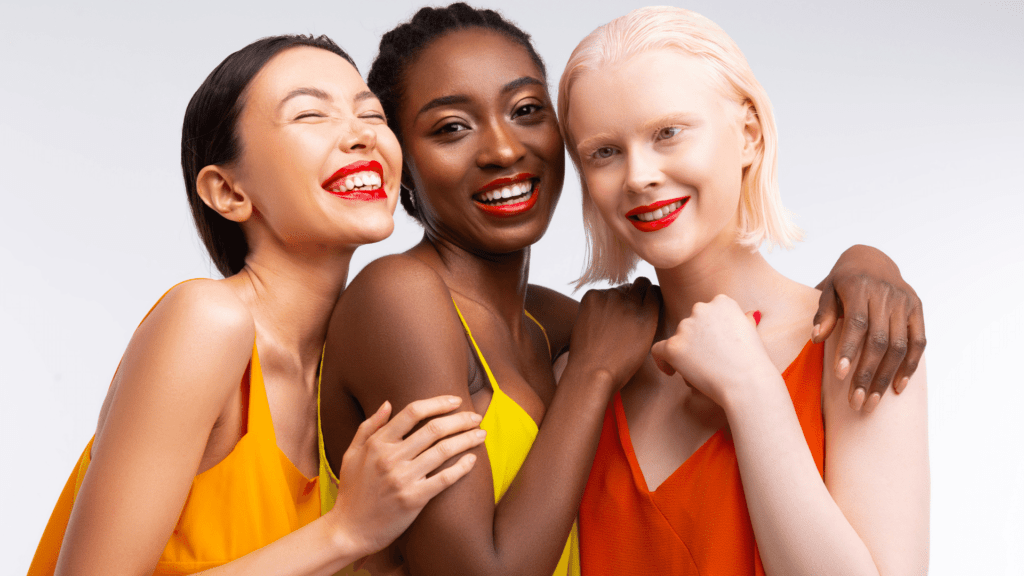
Cool Blue/Rose
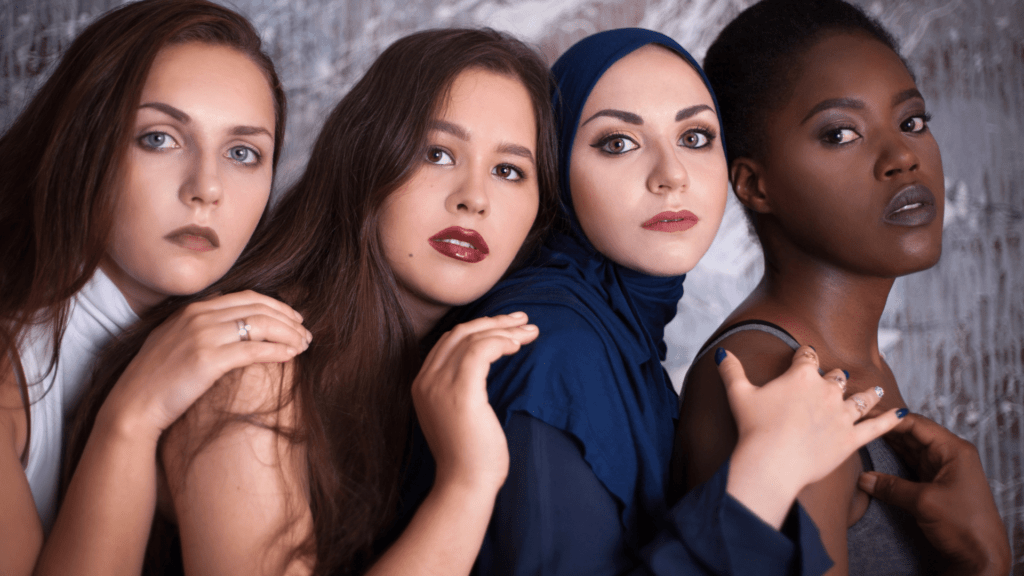
Let’s figure out your undertone, or hue, by checking the inside of your wrist. Your undertone influences which colors look best on you, so it’s important to know. Here’s how:
- If your veins appear more blue or purple, you’re likely cool-toned.
- If they look green, you’re likely warm-toned.
- If you see a mix of colors, you’re likely neutral.
Think back to your answers to uncover the hue:
- Warm undertones typically align with Spring or Autumn.
- Cool undertones usually match with Summer or Winter.
- If you’re neutral, you may find that you have a mix of both warm and cool undertones, making you versatile in wearing a variety of colors.
Understanding your undertone is important because it helps you choose colors that complement your skin tone and make you look your best.
For me, I have both – which means I’m a neutral. I noticed I have more blue and purple than green, which makes sense because my hair and eyes are neutral too, but they lean more cool.
2. Value- Depth: Are You Light or Dark?
Think about your skin tone, natural hair color, and eye color.
Are they generally lighter or darker? There are two light and two dark color seasons. Light matches with Spring or Summer, while Dark goes with Autumn or Winter.
Skin: Light or Dark? Eyes: Light or Dark? Hair: Light or Dark?
Even if they don’t all match perfectly, we’re looking for the dominant value. It’s like a game of rock, paper, scissors – 2 out of 3 wins.
decoding your Answers to Value Questions
- Light = Spring or Summer
- Dark= Autumn or Winter
3. Chroma-Clarity: Muted or Bright
The final step is to determine your chroma, or how bright or muted your coloring is.
We do this so you know if you’re going to need to shop for vibrant colors or soft, subtle colors.
If your natural coloring is bold, and bright, your clothes should be too. If they are softer and muted, then you’ll want to avoid the overpowering intense colors and pick less saturated colored clothing.
Decoding Your Chroma Answers
- Bright = Spring or Winter
- Muted= Summer or Autumn
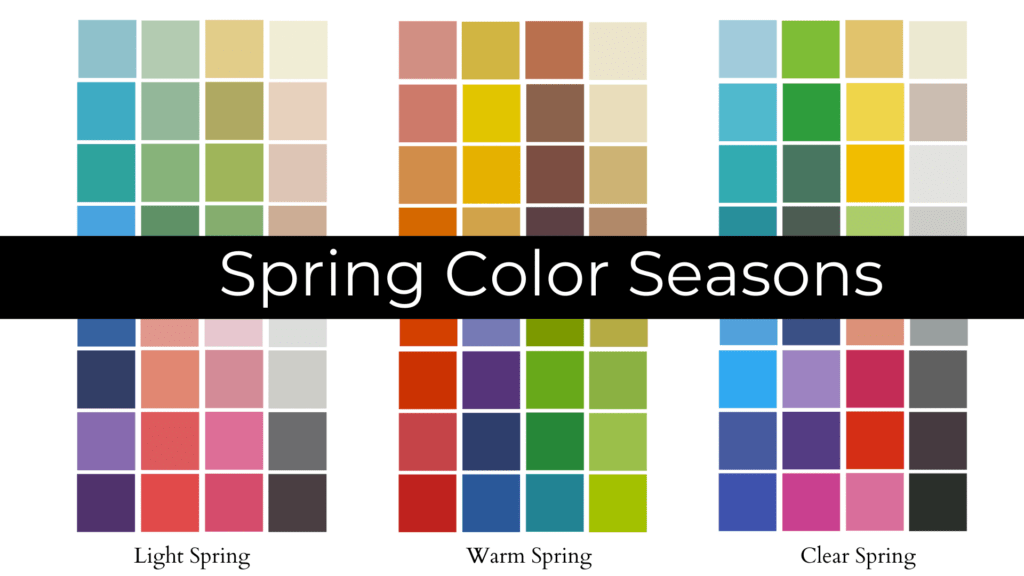
The three spring color seasons are: light spring, warm spring, and clear spring. If you fit into the spring color season you are warm and light dominant.
Now, let’s determine which warm tones and shades look best with your chroma, too.
A light spring has light and warm coloring. If you are a light spring, your hair is likely golden blonde, strawberry blonde, light red, or light golden brown. Additionally, your iris has yellow tints or golden specs.
Light spring is the most muted of the three spring seasons and so is the color palette. The colors of your clothes should complement your color structure.
Pick colors that are:
- Soft and muted
- Warm tones – have a subtle, yellow or green tint.
- Medium to light colors
The best colors for light springs are:
- Neutrals: Light, dusty caramels and lighter, greenish grays.
- Fashion Colors: muted greens, corals, and teals. (Medium-Light shading)
- Darks: Dusty gray, muted brown, and faded navy.
- *Avoid bright colors including crisp white and black.
Warm springs have a lot of yellow in their natural coloring. If you are a warm spring, you also tend to be the best tanned of the spring seasons.
Your eyes are likely yellow-green or golden brown and your hair is golden blonde, red, or brown,
Warm spring can be thought of as lighter version of an autumn color palette. Your clothes follow suit.
Pick colors that are:
- Medium shades
- Warm tones – Rusty yellow hues
- More muted than bright
Warm Spring’s Best Colors are:
- Neutrals- Rusty browns and peachy whites.
- Fashion Colors- Medium mustard yellows, yellowish greens, and reddish oranges.
- Darks- Medium-dark camel browns and faded navy.
- *Avoid bright colors especially bright blue, pink, blacks and crisp whites. e
Clear spring has the brightest coloring of all of the springs. You might have bright blonde, red, or brown hair and vibrant, bright green, or golden eyes. Your clothes should be just and bright a vibrant.
Pick colors that are:
- Warm tones- greens
- Bright and bold colors
- Bright light and medium shades
Clear Springs Best Colors are:
- Neutrals- bright greys, yellow creams, and peachy tans.
- Fashion Colors- Bold yellows, greens and teals.
- Darks-Medium greys with greenish or orange tints, charcoals.
- *Avoid muted light colors and harsh, crisp whites and blacks.
The three summer color seasons are light summer, soft summer, and cool summer.
If you fit into one of the summer color seasons, you are light and cool dominant.
Let’s see which season of summer fits your chroma, or coloring intensity.
Light summers have cool undertones and have lighter hair and eyes.
The light summer color season is the lightest of the summers and the closest to spring. The color of your clothes should be in the same color family as your natural coloring.
Pick colors that are:
- Light to medium in value.
- Cool tones and cool neutrals
- Slightly muted
Your best colors are:
- Neutrals – grayed and rosy neutrals
- Fashion Colors- cool pinks and blues
- Darks- medium browns and muted blue
- *Avoid warm toned bright and dark colors including bright whites and deep blacks.
Soft summers have lighter ash colored hair with soft grayish-green, grayish blue, or grayish brown eyes. You might also have subtle warm or neutral tones mixed in with your coloring.
The soft summer is the warmest of the summer seasons, but still very cool dominant. Clothes that work best will match that color pattern.
Pick colors that are:
- Muted and soft
- Cool and neutral tones
- Medium to darker value
Soft Summers best colors are:
- Neutrals- rosy cream colors, or cool neutrals
- Fashion Colors – Cool, muted pinks and greens
- Darks- Rosy Grays, Medium Browns
- *Avoid deep darks and bright, crisp colors.
Cool summers generally have medium to darker ashy hair and cool, brighter eyes.
This is summer color season with the most contrast between their coloring. Your clothes should also provide contrast.
Pick colors that are:
- Slightly muted
- Cool tones
- Medium to dark shades
Colors that look best on the cool color season are:
- Neutrals- Medium grays and cool creams
- Fashion Colors- Medium value, muted blues, pinks and purples.
- Darks- Deep, muted blues and grays.
- *Avoid browns and any warm toned, bright colors.
The three autumn color seasons are soft autumn, warm autumn, and dark autumn.
If you fit into one of the autumn color seasons, you are dark and warm dominant.
Let’s see which season of autumn fits your chroma, or coloring intensity.
Much like soft summer, soft autumn colors are muted. However, soft autumn leans darker and with warmer tones.
If you are a soft autumn you likely have medium-dark warmer hair and medium to dark eyes.
Your overall coloring blends together well and has a softer, gentle intensity, opposed to dark and bright. Your clothing colors should be similar.
Pick colors that are:
- Medium-Dark
- Slightly Muted
- Warm Tones- Dark muted blues,
- Neutrals- greenish grays and light camels
- Fashion Colors- Warm greens and reddish oranges
- Darks- Dark muted blues, charcoals, and reddish browns.
- *Avoid cool blush tones.
You’re likely a warm autumn if you are on the tanner side, have beautiful medium-dark eyes with golden or amber specs.
Your overall coloring is very warm and golden. Your wardrobe colors should also have golden hues.
Pick colors that are:
- Medium-Dark Tones
- Slightly Muted
- Golden, Warm Hues
- Neutrals-Golden creams and tans
- Fashion Colors- Rich mustard yellows that are slightly muted and copper oranges
- Darks- Darker, warm browns and medium, muted greens and blues.
- *Avoid bright pinks, purples, and crisp, cool tones.
If you are a dark autumn, you have darker, neutral tones that lean more warm.
Dark winter is the least muted of the bunch, but clothing colors should be more rich than bright to match your natural coloring.
Pick colors that are:
- Bold and rich
- Medium-dark
- Slightly muted -rich, but not bright.
Colors that look best on dark autumns are:
- Neutrals- yellow creams and greenish tans
- Fashion Colors- Rich oranges and warm reds.
- Darks- Dark creamy blues and browns.
- *Avoid cool toned pinks and pastels.
The three winter color seasons are clear winter, cool winter, and deep winter.
If you are a winter, you are dark and cool dominant.
Let’s see which sub-season matches your natural color intensity.
Clear winters have brighter, cool features. You might have medium to dark blue eyes or vibrant brown or black eyes.
Clear winter is close to true summer, but it leans more dark and bright. Your clothing color palette should match this.
Pick colors that are:
- Cool Tones
- Medium-Dark
- Bright and Creamy
Clear winters look best in:
- Neutrals- Light bluish grays and muted, rosy pinks.
- Fashion Colors- Bolder, bright blues, pinks, and purples.
- Darks- Deep blues and charcoals.
- Avoid high contrast, warm colors.
Cool winters have high contrast in their coloring with strong cool tones.
True winters or like true summers but lean darker and less muted. Your wardrobe color palette should match your natural color harmony.
Pick colors that are:
- Medium-Dark Shades
- Cool Tones
- Rich and Creamy
Cool Winters look best in:
- Neutrals- True grays and blues
- Fashion Colors- Rich reds, blues, and purples.
- Darks- Crisp blacks and deep grays.
- *Avoid muted, warm tones.
Deep winters have natural dark cool or neutral coloring.
Your color system is overall dark and somewhat muted. Your wardrobe coloring should be similar.
Pick colors that are:
- Darker (More black mixed in opposed to white.)
- Deep and Muted
- Cool tones
Deep winters look best in:
- Neutrals- Neutral whites and grays with dark tints
- Fashion Colors- Medium-dark reds and purples
- Darks- Dark charcoals and blues.
- *Avoid bright warm tones.
Conclusion: Color Seasons
When you know which of the 12 color seasons you fall into. You can supercharge your shopping power. So long are the days of staring into a sea of colors and blinding choosing the ones that look good on the rack.
Color season analysis helps you pick the colors that are going to help you look perfectly polished, healthy, and vibrant.
Like most things, color analysis starts with spotting what you’ve got first. You discover your hue, value, and chroma and that will lead you down a powerful path to one of the 12 color seasons.


